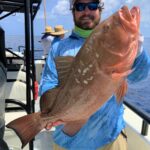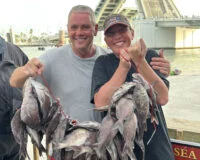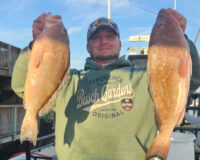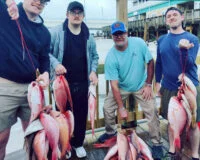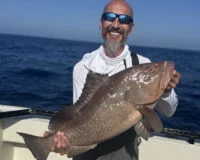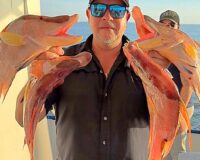Hubbard's Marina Fishing Report
Inshore Fishing Report
Red Tide just seemingly will not go away in the area. We continue to see a bouncing level of red tide around the area. Mostly along the gulf coast and beaches and around some areas north of Tampa Bay in the intercoastal waterways. Nothing super wild with big fish kills but still seeing sporadic fish kills and some heavy enough concentrations to feel the tickle in your throat and make your eyes water when the water gets churned up or Rough. Early this past week around 4-6 miles NW of Johns pass we found a very large area off the coast with a big fish kill and heavily concentrated bloom present. Disappointing to see this when there’s huge schools of red fish along the coastline breeding. Also, we still have good old piney point now nearly full and ready to be dumped into Tampa bay yet again. This is something we need to watch carefully because I feel this will just reignite a very concentrated disastrous red tide bloom in the bay around 1-3 months following the dump especially with the bloom still present in the area. Keep an eye on the forecasts and reports via this link if you are interested -> http://ocgweb.marine.usf.edu/tbm/hab/
Redfish action has been yet again very impressive around the area. Our friends Joe and Luke Simonds from Salt strong reported this past week they had a crazy bite of redfish fishing shallow waters early in the morning chasing schools of mullet along the flats and mangrove shorelines. Essentially where you found the mullet foraging heavily along the flats that’s where you could find feeding redfish following along and preying on all the bait fish and crustaceans the mullet disturbed in their feeding. Shallow waters less than 2-3 foot seem to be the best areas to find these fish. Also, earlier in the day this time of year when the water is hot you are significantly more likely to find the redfish active along the flats, shorelines, and oyster bars of our area. Soft plastic paddle tails like the zman ‘slam shady’ or the moonwalker top water artificials seem to be best options to get the redfish chewing. Using artificials allows you to cover a larger area of the flats more easily and follow those schools of mullet. If you can’t do this, live shrimp is a great option or cut bait. During the heat of the day, the redfish action has been good around the sandy passes holding to structures. We had several redfish caught around Johns Pass, blinds pass and clearwater pass this past week around those deeper sandy areas adjacent to docks, piers, bridges, and jetties. Using live shrimp or the swim baits or soft plastics right on the bottom is the best option for these areas. Keep in mind during the dead of night bridge lights and dock lights will also provide an opportunity to catch some reds butt they will always be at the bottom and look for docks or bridges where water is moving, and bait is present. My favorite dock lights are always near the points of canal entrances adjacent to the passes, choke points or near grass flats where tides are pulling water from the flat to the docks.
Snook action is going well around the area too but was a little softer compared to the redfish show. We are seeing a majority of the snook be the schoolie sized more active juvenile fish during the day on the flats. However, if you can soak out the edges of the flats or the deeper holes around the flats with big cut bait you can find the big breeder sized fish. Most of the time, the bigger snook are caught at night this time of year around the bridges, big dock structures and deeper areas around the flats at night fall, through the night, or early morning. During the heat of the day those big fish even when located are often just going to chill and wait for the cooler temps set in to feed. Fishing the shadow lines of bridges and docks at night is a great way to target the bigger snook. They get extremely opportunistic and leader shy in these warmer waters. Some hardcore pass fishermen will throw those big flairhawks, bomber lipped plugs, or the bigger swim baits to target the big girls moving through the passes. You may not have the action using these lures compared to a soft plastic or rattletrap but when you get hit your typically seeing bigger fish. Smaller 8-12 inch mullet make extreme cut baits or even live baits around the bases of bridges for targeting the bigger snook. However, if you want the most action using smaller artificial baits or live shrimp and lighter tackle is best.
Trout action still going steady around the area, but they are still holding to the deeper flats during the day where there’s a bit cooler water. Also, we are seeing them along our beach fishing piers, around local bridges and passes, plus along the beaches too. Look for them in the swash channels of the beaches hunting soft plastic paddletails, live shrimp or the white bait. Hard to find white bait of size right now but live shrimp is a great second option. Still some snook and redfish cruising the beaches too right now as well in the swash channels with the trout. Early morning, dusk or through the night continues to be the best time to find more actively feeding fish.
Mangrove snapper action is really going well around the area too and typically around this time of year is our last big chance for targeting the plethora of snapper inshore. Once October rolls in the cold fronts will eventually get started up and the snapper spread out and the bigger ones will be triggered to move near shore and offshore with the moon phases. Get them while they are biting well around those structures, rock piles and bridges. Great time to target them is right on the start of the incoming or outgoing tide just as the water starts to move but is still moving slowly.
Sheepshead are around may local structures still and you will often see them or find them intermixed with the snapper around the local bridges, docks, seawalls and even sometimes out on the flats. They will only get more prolific and concentrated as the water cools, but for now you can still get lucky when targeting mangrove snapper on lighter tackle with smaller hooks and a small chunk of shrimp.
Mackerel are biting well along our coastal fishing piers and bridges of tampa bay. We are seeing larger areas of bait schools which are holding typically plenty of mackerel. Plus, the jack crevalle too are getting more and more prolific in the area as well. If you find the bait being actively fed on when they are up on the surface disrupting the surface of the water and attracting birds to dive on them its always thanks to some hungry predatory fish below and ninety nine percent of the time that’s going to be a big school of mackerel or jacks. Fast moving flashy lures are always best for these hungry and aggressive fish.
Pompano action is slow and steady around the beaches, local fishing piers and bridges near the mouth of the passes and the bay. We are starting to see them more frequently but they will pick up as ‘fall’ approaches and that transition between the hot summer time water and cooler ‘wintertime’ water sets in. Look for them in those clearer water areas where water is moving. Live shrimp, pompano jigs or the small soft plastics are great options to target these fish right on the sandy bottom areas.
Triple tail are thick around the beaches and around the bay right now. Great time to hunt the buoys, markers and keep an eye out for floating debris from upper to lower Tampa bay and along the flats, beaches and even once offshore!
Nearshore Fishing Report
We had a killer bite of red grouper early to middle of this past week prior to the little weather disturbance we have had. They were biting extremely well for us right ahead of that low approaching the area. We are finding them best around the 80-100ft mark and doing best using larger dead baits. Unfortunately, it seems the red grouper bite is only getting better and better, but we will see an announcement next week that red grouper will be closing for the year due to the ACL or Annual Catch Limit being met or projected to be met. This is frustrating, annoying, and sad but its good news too. Want to know why? Well, that shows the fishery is rebounding and they are recovering, and science supports this idea. We have seen the council’s SSC or Science and Statistical Committee raise the average red grouper size this year with their review of the SEFSC or Southeast Fisheries Science Center’s interim analysis. This means the overall average size of the red grouper caught is getting larger which is a great signal of the stock’s overall health improving. However, with a larger average size comes the likelihood that the quota will be caught up more quickly. Plus, couple that change with the fact we are really catching them well, and it adds up to a very strong likelihood of a closure. I figured this would happen and my thoughts were confirmed at the last gulf council meeting when they reviewed reef fish landings and even stated there’s likely a red grouper ACL closure coming. I had hoped it would come later in the year, but we will likely see it follow shortly after their announcement coming next week. The other positive news is that the council currently has two framework actions in the mix right now that will help improve the recreational quota and catch level for the entire fishery. These changes will hopefully be in effect prior to end of summer or fall next year which should and likely will allow us to get nearly a full 12 month season back in 2022. Very frustrating this year, but again its good news the fishery is rebounding and us giving them a break for a few months at the end of this year should help even more with the red grouper really making a strong bounce back.
We are also seeing a lot of lane snapper near shore right now on the cut threadfin, small squid chunks and live shrimp. Plus, the mangroves are nearly almost as present near shore just a bit trickier to get eating like the lane snapper. We are extremely excited to see what these guys will do as that water temp starts to dip a bit a lot of times, they get feistier and more prolific.
Hogfish action is present, not going super well, but they are present and when focused on you can really catch a decent number. However, the hogfish bite is just around the corner from really turning up to a great option near shore.
Mackerel are more prolific near shore right now and were just a few weeks away from the kingfish making an appearance near shore. Likely this upcoming full moon on the 21st of September people will start to see a few schoolie sized kings near shore and along the beaches but they should be in full swing by early to mid-October if weather patterns hold to the norms. My only concern is the red tide along the coastline if that stays there, we could see the kingfish skip the near shore waters and stay deeper kind of like we witnessed this past spring.
Offshore Fishing Report
Amberjack fishing has gotten tough on us recently but were still plugging away at hunting them here and there. I thought this year we would see a very slow august – October amberjack bite when their season re opened but I was proved wrong through most of August into September when we had really decent amberjack action on our long-range trips. However, the last few 39 hour trips saw a severe change in that pattern and we are still struggling to find big concentrations of these fish while bouncing around offshore on the Flying HUB 2 private fishing charters and the 12 hour extreme. Hopefully, we are going to see another push of these fish prior to the end of October when their season will close again until May of next year.
Red grouper action is going well out deep right now too and it’s a great time to get them while you can prior to that closure we talked so much about in the near shore section comes into place. We are seeing them well around that 120-160ft area but the deeper you go the bigger they get. Still, plenty of smaller undersized fish mixed in with them and its super important to make sure you have a good dehooker and barotrauma mitigation device ready. Some prefer the descending devices some prefer venting tools, but either way you just must have one or the other ready to rock and roll when fishing offshore and even in the deeper near shore waters when the water is this hot.
Mangrove snapper have been super cooperative and very large overall when fishing out there around 120-160ft of water hunting those red grouper, gag grouper and scamp. Using the tried and true double snell rig with the typical Carolina rig set up is the primary method for the mangrove snapper with around 40-50lb test leader and around 5-6ot hooks and a cut chunk of threadfin.
We are seeing a good number of yellowtail snapper around still as well. Plus, the vermillion, porgies, and lane snapper mixed in with the mangroves offshore too so plenty of action while targeting your mangroves, gags, scamp, and red grouper.
Once red grouper closes, we will really hunt the scamp, gags, mangroves, yellowtail and other heads and tails. Plus, were going to see the tuna and kingfish pick up as October rolls in plus the chance for big wahoo is still around too!

